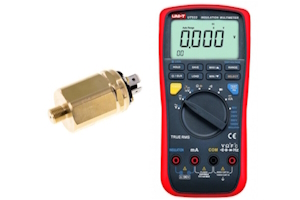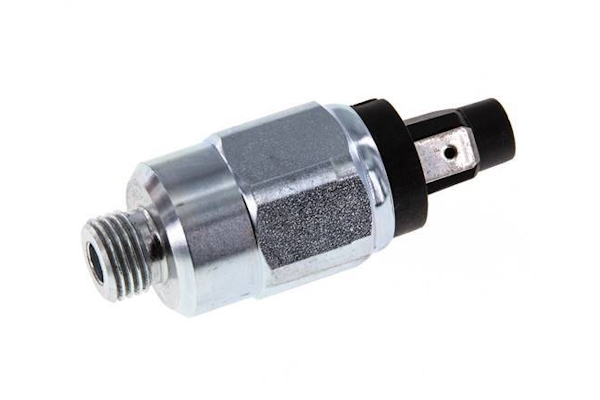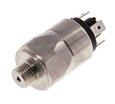How To Test an HVAC Pressure Switch

Figure 1: Having a multimeter on hand is necessary to test a pressure switch efficiently
Ensuring the proper functioning of an HVAC pressure switch is necessary for the safety, efficiency, and longevity of heating, ventilation, and air conditioning systems. These switches play a critical role in monitoring and regulating the pressure within furnaces and air conditioning units, acting as safeguards against pressure levels that are too high or too low, which can lead to equipment failure or safety hazards. This proactive approach to maintenance can significantly extend the lifespan of HVAC units, reduce the need for costly repairs, and maintain a safe environment for occupants.
Table of contents
- Where to find a pressure switch
- Testing a pressure switch with a multimeter
- Troubleshooting a faulty pressure switch
View our online selection of pressure switches!
Where to find a pressure switch
Identifying the location of a pressure switch in HVAC systems, particularly in furnaces and A/C units, is essential for maintenance, troubleshooting, and ensuring the longevity of the equipment.
Furnaces
In a furnace, the pressure switch is typically found in close proximity to the draft inducer motor. The draft inducer motor, a critical component, ensures the evacuation of exhaust gasses from the furnace. To locate the pressure switch:
- Begin by turning off the furnace to ensure safety during inspection.
- Open the furnace’s access panel. This may require the removal of screws or latches.
- Look for a small, round, or rectangular component connected to the draft inducer motor via a rubber tube. This is the pressure switch.
- The pressure switch may also be mounted on the furnace’s body, with wires leading to the control board and a tube connecting it to the draft inducer motor.
Air conditioning systems
Air conditioning units utilize pressure switches to monitor and regulate the pressure of refrigerants, ensuring optimal operation. To find the pressure switch in an A/C system:
- Ensure the A/C unit is powered off before beginning your search.
- Access the condensing unit, usually located outside the home or building.
- The pressure switch is typically near the compressor or along the refrigerant lines. It is often encased in a protective cover.
- Look for a component with electrical wiring connected to the control board and a tube or sensor that extends into the refrigerant line.

Figure 2: A high pressure switch suitable for an A/C condenser.
Key considerations
Always refer to the manufacturer’s manual for specific diagrams and instructions related to the pressure switch in the HVAC system.
If unsure about the location or function of the pressure switch, consult a professional HVAC technician to prevent accidental damage or safety hazards.
Testing a pressure switch with a multimeter
Testing a pressure switch with a multimeter efficiently determines whether it is operating as intended. Users can test for continuity, resistance, or voltage.
Testing for continuity or resistance
When testing a furnace pressure switch or an A/C pressure switch for resistance or continuity, remember that the results should be opposite for these two types of switches. A/C pressure switches are normally closed, so there should be continuity in the switch when there is no power running to the switch. Furnace pressure switches, alternatively, are normally open and there should be no continuity across the switch when there is no power running to the switch.
Here's a step-by-step guide on how to perform these tests.
- Safety first
- Turn off power: Ensure the power to the HVAC system is completely turned off at the breaker. This is crucial to prevent any electrical shock or damage.
- Access the pressure switch: See the above section to know where to find a pressure switch in a furnace or A/C condenser.
- Testing continuity
- Set the multimeter: Turn the multimeter knob to the continuity setting. This is often represented by a symbol that looks like a sound wave or the diode symbol. If the multimeter beeps when the probes are touched together, it has a continuity sound feature.
- Disconnect the switch: Carefully disconnect the electrical connectors or wires from the pressure switch. The switch is tested independently of the rest of the system.
- Test continuity: Touch one multimeter probe to one terminal of the pressure switch and the other probe to the other terminal. If the switch is closed (A/C pressure switch) the multimeter should show continuity. If the switch is open (furnace) the switch should show no continuity or open line (OL). In both instances, the switch is working properly.
- Testing resistance
- Set multimeter to resistance: Change the multimeter setting to measure resistance, which is often denoted by the omega (Ω) symbol.
- Measure resistance: With the electrical connectors still disconnected, measure the resistance across the terminals of the pressure switch. A normally operating A/C pressure switch should show very low resistance, close to zero ohms, when the system is at a normal operating pressure. High resistance or OL (open loop) indicates a problem with the switch. A functioning furnace pressure switch should have no resistance when the furnace is powered down, and resistance when the furnace inducer motor turns on.
Testing voltage
Testing the voltage of an HVAC pressure switch is easy with a furnace pressure switch and more difficult for an A/C pressure switch. This is because the wires carrying load to a furnace pressure switch are much easier to access. Therefore, this section focuses only on furnaces. Follow these steps:
- If necessary, connect the power supply wires to the pressure switch.
- Place both multimeter leads to the terminals on the pressure switch. With the furnace powered off, the multimeter should not show a voltage reading.
- Turn on the furnace and wait for the thermostat to call for heat. When it does, the multimeter will show the voltage signal coming from the thermostat, which is typically 24V.
- After a few moments, the voltage reading on the multimeter should drop back down to 0V if the switch is properly closed.
- If the reading on the multimeter does not drop down to 0V, then the pressure switch is broken or there is something wrong with the draft created by the motor.
Note: If a pressure switch is found to be faulty it should be replaced. Read our article on HVAC pressure switch replacement to learn more.
Troubleshooting a faulty pressure switch
Fixing a faulty pressure switch in a furnace or air conditioning condenser involves several steps. This section describes some quick tips to deal with a faulty pressure switch. However, the switch may fail again soon after fixing, and it may be better to replace the switch altogether. Read our article on installing mechanical pressure switches to learn more.
- Safety first - turn off power: Always start by turning off the power to your furnace or A/C unit to prevent any electrical accidents.
- Check the manual: Refer to the system’s manual for specific safety precautions and instructions.
- Visual inspection: Check the pressure switch for any visible damage, such as cracks or burns.
- Check the tubing: Inspect the tubing connected to the pressure switch for clogs, cracks, or disconnections. Sometimes, clearing a clog or replacing the tubing fixes the issue.
- Test the pressure switch: Use a multimeter to test the continuity of the pressure switch. With the HVAC system off, the switch should be open (no continuity). When the system is on and operating at the correct pressure, the switch should close (show continuity). If the switch does not close when it should, it may be faulty. Learn more in the next section.
- Cleaning: If the switch and tubing appear to be in good condition, try carefully cleaning them. Dust or debris can sometimes cause the switch to malfunction.
- Check system pressure: If the pressure switch seems operational but is frequently opening or causing the system to shut down, verify that the system's pressure is within the manufacturer's specified range. Pressure issues can be due to leaks, blockages, or problems with the compressor.
- Adjusting pressure settings: Some pressure switches allow for adjustment. If the system’s manual provides guidelines for this, ensure the settings are correct.
- Professional help: If there is uncertainty at any point about performing these steps, or if the problem persists after the attempt to fix it, it’s best to seek professional assistance.
- Warranty: Be aware that performing repairs may void any existing warranty on the system. Check the warranty terms before proceeding.
FAQs
How to test a pressure switch with a multimeter?
Set the multimeter to continuity mode, disconnect the switch, and test for continuity. No continuity indicates a faulty switch.
How to test a furnace pressure switch?
Disconnect power, remove wires from the switch, and use a multimeter in continuity mode to check if the switch closes when the furnace is on.
Testing a pressure switch: what signs indicate failure?
A pressure switch fails if it shows no continuity when the system is running or if it doesn't open when the system is off.







